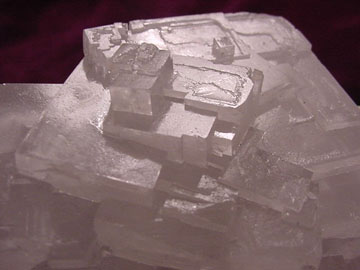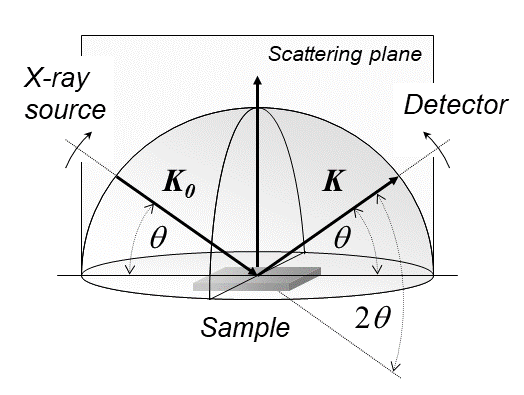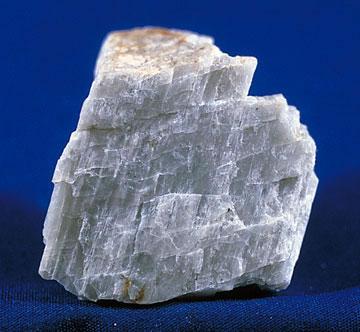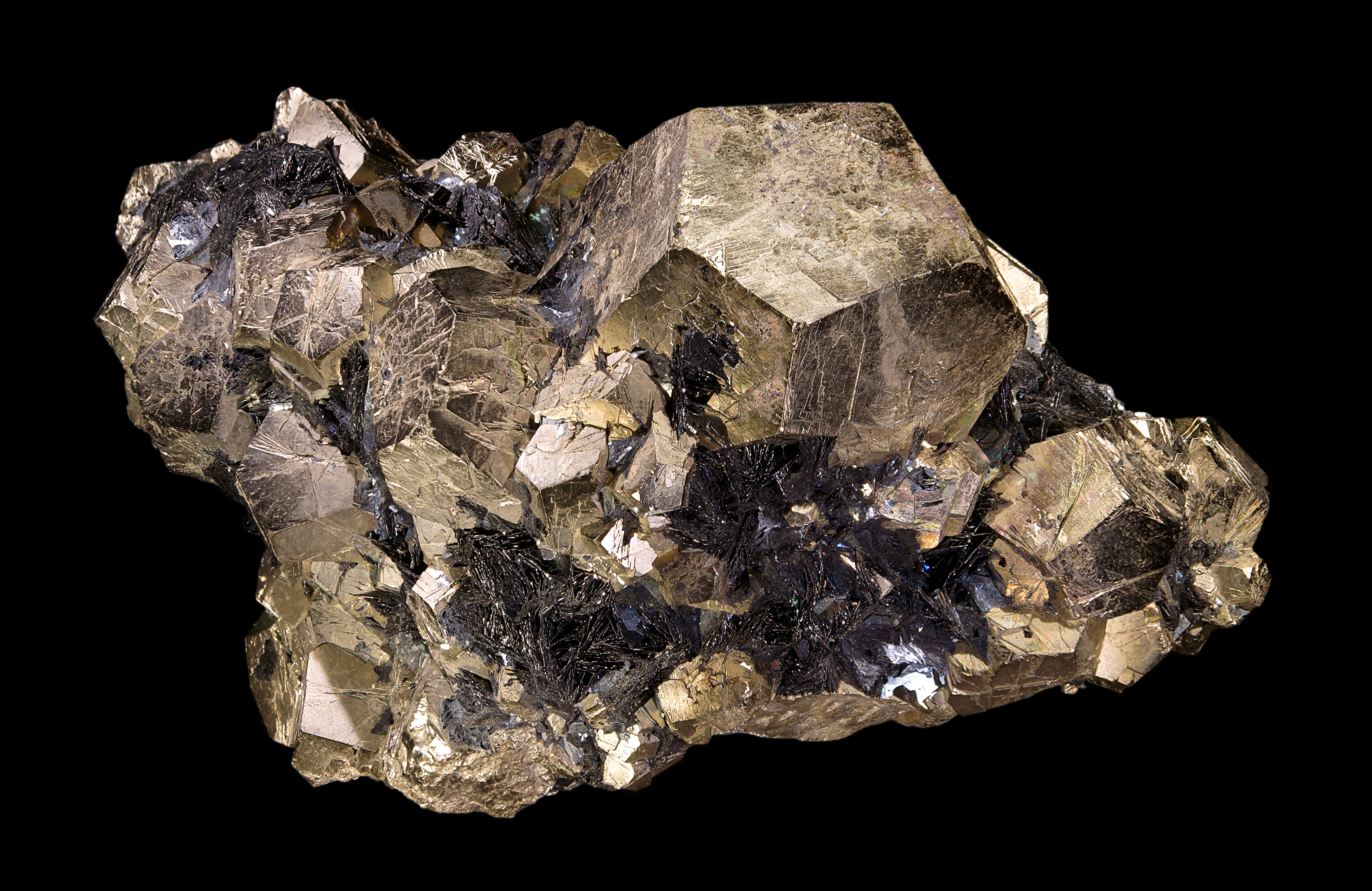|
Hibbingite
Hibbingite is a divalent iron hydroxychloride found in the Duluth Complex of northeastern Minnesota, United States. Hibbingite can be found in troctolitic, partially serpentinized rocks. Hibbingite can also be found in sulfide ore from the Sudbury Complex, Canada, the Noril’sk Intrusion in Russia, and in terrestrially weathered meteorites. Hibbingite is mostly found as vein filings from drill cores taken from troctolitic, partially serpentinized rocks. Hibbingite itself can have cleavage perpendicular to the vein walls in which it is found. Hibbingite is associated with serpentine, olivine, plagioclase, biotite, and secondary magnetite or goethite. Fresh samples are internally green but turn reddish as they oxidize. Hibbingite is part of the atacamite family of minerals. Naming Hibbingite is named after the town of Hibbing, Minnesota. Hibbingite is preserved at the drill core library of the Department of Natural Resources in Hibbing Minnesota. Occurrence Hibbingite occurs in ... [...More Info...] [...Related Items...] OR: [Wikipedia] [Google] [Baidu] |
Halide Mineral
Halide minerals are those minerals with a dominant halide anion (, , and ). Complex halide minerals may also have Polyatomic ion, polyatomic anions. Examples include the following: *Atacamite *Avogadrite (K,Cs)BF *Bararite (β) *Bischofite *Brüggenite *Calomel *Carnallite *Carnallite *Cerargyrite/Horn silver AgCl *Chlorargyrite AgCl, bromargyrite AgBr, and iodargyrite AgI *Cryolite *Cryptohalite (a) . *Dietzeite *Eglestonite *Embolite AgCl+AgBr *Eriochalcite *Fluorite *Halite NaCl *Lautarite *Marshite CuI *Miersite AgI *Nantokite CuCl *Sal Ammoniac *Sylvite KCl *Terlinguaite *Tolbachite *Villiaumite NaF *Yttrocerite (Ca,Y,Ce)F2 *Yttrofluorite (Ca,Y)F2 *Zavaritskite (BiO)F Many of these minerals are water-soluble and are often found in ar ... [...More Info...] [...Related Items...] OR: [Wikipedia] [Google] [Baidu] |
Atacamite
Atacamite is a copper halide mineral: a copper(II) chloride hydroxide with formula Cu2Cl(OH)3. It was first described for deposits in the Atacama Desert of Chile in 1802 by Dmitri de Gallitzin. The Atacama Desert is also the namesake of the mineral. Occurrence Atacamite is polymorphous with botallackite, clinoatacamite, and paratacamite. Atacamite is a comparatively rare mineral, formed from primary copper minerals in the oxidation or weathering zone of arid climates. It has also been reported as a volcanic sublimate from fumarole deposits, as sulfide alteration products in black smokers. The mineral has also been found naturally on oxidized copper deposits in Chile, China, Russia, Czech Republic, Arizona, and Australia. It occurs in association with cuprite, brochantite, linarite, caledonite, malachite, chrysocolla and its polymorphs. Synthetic Occurrence Atacamite has been discovered in the patina of the Statue of Liberty, and as alteration of ancient bronze and copp ... [...More Info...] [...Related Items...] OR: [Wikipedia] [Google] [Baidu] |
Orthorhombic Minerals
In crystallography, the orthorhombic crystal system is one of the 7 crystal systems. Orthorhombic lattices result from stretching a cubic lattice along two of its orthogonal pairs by two different factors, resulting in a rectangular prism with a rectangular base (''a'' by ''b'') and height (''c''), such that ''a'', ''b'', and ''c'' are distinct. All three bases intersect at 90° angles, so the three lattice vectors remain mutually orthogonal. Bravais lattices There are four orthorhombic Bravais lattices: primitive orthorhombic, base-centered orthorhombic, body-centered orthorhombic, and face-centered orthorhombic. For the base-centered orthorhombic lattice, the primitive cell has the shape of a right rhombic prism;See , row oC, column Primitive, where the cell parameters are given as a1 = a2, α = β = 90° it can be constructed because the two-dimensional centered rectangular base layer can also be described with primitive rhombic axes. Note that the length a of the prim ... [...More Info...] [...Related Items...] OR: [Wikipedia] [Google] [Baidu] |
X-ray Diffraction
X-ray diffraction is a generic term for phenomena associated with changes in the direction of X-ray beams due to interactions with the electrons around atoms. It occurs due to elastic scattering, when there is no change in the energy of the waves. The resulting map of the directions of the X-rays far from the sample is called a diffraction pattern. It is different from X-ray crystallography which exploits X-ray diffraction to determine the arrangement of atoms in materials, and also has other components such as ways to map from experimental diffraction measurements to the positions of atoms. This article provides an overview of X-ray diffraction, starting with the early #History, history of x-rays and the discovery that they have the right spacings to be diffracted by crystals. In many cases these diffraction patterns can be #Introduction to x-ray diffraction theory, Interpreted using a single scattering or kinematical theory with conservation of energy (#Ewald's sphere, wave vecto ... [...More Info...] [...Related Items...] OR: [Wikipedia] [Google] [Baidu] |
Norilsk
Norilsk ( rus, Нори́льск, p=nɐˈrʲilʲsk) is a closed city in Krasnoyarsk Krai, Russia, located south of the western Taymyr Peninsula, around 90 km east of the Yenisei, Yenisey River and 1,500 km north of Krasnoyarsk. Norilsk is 300 km north of the Arctic Circle and 2,400 km from the North Pole. It has a permanent population of 176,735 as of 2024, and up to 220,000 including temporary inhabitants. It is the second-largest city in the region after Krasnoyarsk. Since 2016, Norilsk's population has grown steadily. In 2017, for the first time, migration to the city exceeded outflow. In 2018, according to Krasnoyarskstat, natural population growth amounted to 1,357 people: 2,381 were born, and 1,024 died. It is the world's List of northernmost items#Cities and settlements, northernmost city with more than 180,000 inhabitants, and the second-largest city (after Murmansk) inside the Arctic Circle. Norilsk and Yakutsk are the only large cities in the continuous permafrost zon ... [...More Info...] [...Related Items...] OR: [Wikipedia] [Google] [Baidu] |
Biotite
Biotite is a common group of phyllosilicate minerals within the mica group, with the approximate chemical formula . It is primarily a solid-solution series between the iron- endmember annite, and the magnesium-endmember phlogopite; more aluminous end-members include siderophyllite and eastonite. Biotite was regarded as a mineral ''species'' by the International Mineralogical Association until 1998, when its status was changed to a mineral ''group''. The term ''biotite'' is still used to describe unanalysed dark micas in the field. Biotite was named by J.F.L. Hausmann in 1847 in honor of the French physicist Jean-Baptiste Biot, who performed early research into the many optical properties of mica. Members of the biotite group are sheet silicates. Iron, magnesium, aluminium, silicon, oxygen, and hydrogen form sheets that are weakly bound together by potassium ions. The term "iron mica" is sometimes used for iron-rich biotite, but the term also refers to a flaky micace ... [...More Info...] [...Related Items...] OR: [Wikipedia] [Google] [Baidu] |
Plagioclase
Plagioclase ( ) is a series of Silicate minerals#Tectosilicates, tectosilicate (framework silicate) minerals within the feldspar group. Rather than referring to a particular mineral with a specific chemical composition, plagioclase is a continuous solid solution series, more properly known as the plagioclase feldspar series. This was first shown by the German mineralogist Johann F. C. Hessel, Johann Friedrich Christian Hessel (1796–1872) in 1826. The series ranges from albite to anorthite endmembers (with respective compositions NaAlSi3O8 to CaAl2Si2O8), where sodium and calcium atoms can substitute for each other in the mineral's crystallography, crystal lattice structure. Plagioclase in hand samples is often identified by its polysynthetic crystal twinning or "phonograph record, record-groove" effect. Plagioclase is a major constituent mineral in Earth's crust and is consequently an important diagnostic tool in petrology for identifying the composition, origin and evolutio ... [...More Info...] [...Related Items...] OR: [Wikipedia] [Google] [Baidu] |
Olivine
The mineral olivine () is a magnesium iron Silicate minerals, silicate with the chemical formula . It is a type of Nesosilicates, nesosilicate or orthosilicate. The primary component of the Earth's upper mantle (Earth), upper mantle, it is a common mineral in Earth's subsurface, but weathers quickly on the surface. Olivine has many uses, such as the gemstone peridot (or chrysolite), as well as industrial applications like metalworking processes. The ratio of magnesium to iron varies between the two endmember (mineralogy), endmembers of the solid solution series: forsterite (Mg-endmember: ) and fayalite (Fe-endmember: ). Compositions of olivine are commonly expressed as Mole (unit), molar percentages of forsterite (Fo) and/or fayalite (Fa) (''e.g.'', Fo70Fa30, or just Fo70 with Fa30 implied). Forsterite's melting temperature is unusually high at atmospheric pressure, almost , while fayalite's is much lower – about . Melting temperature varies smoothly between the two end ... [...More Info...] [...Related Items...] OR: [Wikipedia] [Google] [Baidu] |
Hibbing, Minnesota
Hibbing is a city in St. Louis County, Minnesota, Saint Louis County, Minnesota, United States. The population was 16,214 at the 2020 United States census, 2020 census. The city was built on mining the rich iron ore of the Mesabi Iron Range and still relies on that industry today. At the edge of town is the world's largest open-pit iron mine, the Hull–Rust–Mahoning Open Pit Iron Mine. It is the hometown of singer-songwriter Bob Dylan, NBA Hall-of-Famer Kevin McHale (basketball), Kevin McHale, MLB outfielder Roger Maris, and former Governor of Minnesota Rudy Perpich. Hibbing's main routes are U.S. Route 169 in Minnesota, U.S. Highway 169, Minnesota State Highway 37, State Highway 37, Minnesota State Highway 73, State Highway 73, Howard Street, and 1st Avenue. It is about northwest of Duluth, Minnesota. History The town was founded in 1893 by Frank Hibbing, born in Walsrode, Germany, on December 1, 1856, and christened Franz Dietrich von Ahlen. His mother died when he was s ... [...More Info...] [...Related Items...] OR: [Wikipedia] [Google] [Baidu] |
Iron
Iron is a chemical element; it has symbol Fe () and atomic number 26. It is a metal that belongs to the first transition series and group 8 of the periodic table. It is, by mass, the most common element on Earth, forming much of Earth's outer and inner core. It is the fourth most abundant element in the Earth's crust, being mainly deposited by meteorites in its metallic state. Extracting usable metal from iron ores requires kilns or furnaces capable of reaching , about 500 °C (900 °F) higher than that required to smelt copper. Humans started to master that process in Eurasia during the 2nd millennium BC and the use of iron tools and weapons began to displace copper alloys – in some regions, only around 1200 BC. That event is considered the transition from the Bronze Age to the Iron Age. In the modern world, iron alloys, such as steel, stainless steel, cast iron and special steels, are by far the most common industrial metals, due to their mechan ... [...More Info...] [...Related Items...] OR: [Wikipedia] [Google] [Baidu] |
Sulfide Mineral
The sulfide minerals are a class of minerals containing sulfide (S2−) or disulfide () as the major anion. Some sulfide minerals are economically important as metal ores. The sulfide class also includes the selenide mineral, selenides, the telluride mineral, tellurides, the arsenide mineral, arsenides, the antimonide mineral, antimonides, the bismuthinides, the sulfarsenides and the sulfosalts.http://www.minerals.net/mineral/sort-met.hod/group/sulfgrp.htm Minerals.net Dana Classification, SulfidesKlein, Cornelis and Cornelius S. Hurlbut, Jr., 1986, ''Manual of Mineralogy'', Wiley, 20th ed., pp 269-293 Sulfide minerals are inorganic compounds. Minerals Common or important examples include: * Acanthite *Chalcocite *Bornite *Galena *Sphalerite *Chalcopyrite *Pyrrhotite *Millerite *Pentlandite *Covellite *Cinnabar *Realgar *Orpiment *Stibnite *Pyrite *Marcasite *Molybdenite Sulfarsenides: *Cobaltite *Arsenopyrite *Gersdorffite Sulfosalts: *Pyrargyrite *Pro ... [...More Info...] [...Related Items...] OR: [Wikipedia] [Google] [Baidu] |






